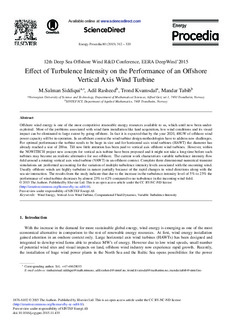Effect of turbulence intensity on the performance of an offshore vertical axis wind turbine
Journal article, Peer reviewed
Published version
Permanent lenke
http://hdl.handle.net/11250/2478947Utgivelsesdato
2015Metadata
Vis full innførselSamlinger
- Publikasjoner fra CRIStin - SINTEF AS [5801]
- SINTEF Digital [2501]
Sammendrag
Offshore wind energy is one of the most competitive renewable energy resources available to us, which until now been under- exploited. Most of the problems associated with wind farm installation like land acquisition, low wind conditions and its visual impact can be eliminated to large extent by going offshore. In fact it is expected that by the year 2020, 40GW of offshore wind power capacity will be in operation. In an offshore context the wind turbine design methodologies have to address new challenges. For optimal performance the turbine needs to be huge in size and for horizontal axis wind turbines (HAWT) the diameter has already reached a size of 200m. Till now little attention has been paid to vertical axis offshore wind turbines. However, within the NOWITECH project new concepts for vertical axis turbine have been proposed and it might not take a long time before such turbines may become an realistic alternative for use offshore. The current work characterizes variable turbulence intensity flow field around a rotating vertical axis wind turbine (VAWT) in an offshore context. Complete three dimensional numerical transient simulations are performed accounting for the variation of multiple turbulence intensity levels associated with the oncoming wind. Usually offshore winds are highly turbulent in nature partially because of the rapid changes in wind directions along with the sea-air interaction. The results from the study indicate that due to the increase in the turbulence intensity level of 5% to 25% the performance of wind turbine decreases by almost 23% to 42% compared to no turbulence in the incoming wind field.

